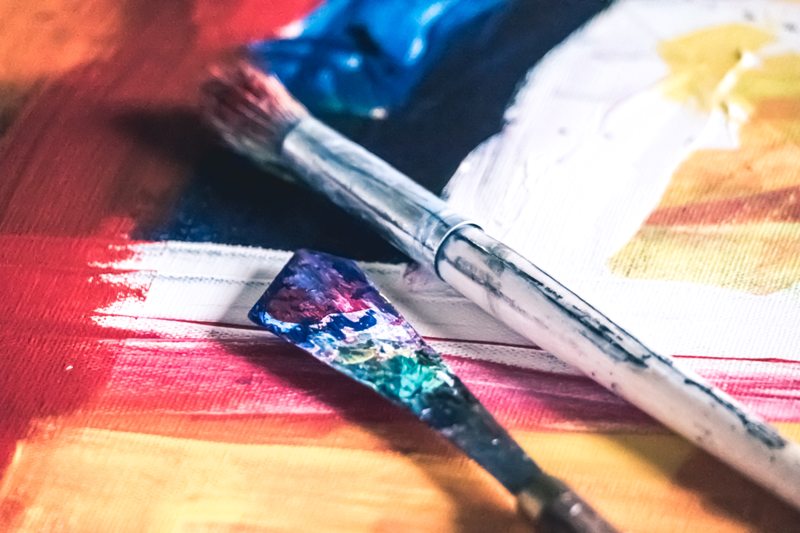You can use acrylic paint on wood. If you are working on a project and wondering if you can use acrylic paint on wood then you are in the right place. We are going to provide you with the do’s and don’t’s and much more information that you need to know when it comes to using acrylic paint on wood.
How to Use Acrylic Paint on Wood
Before anything else, you will need to prepare the wood surface so that the paint will adhere to it when you finally get to apply it.
Here are the materials that you need:
- Sandpaper
- Primer
- A paintbrush
- A paint palette
- Acrylic paint for wood
Prep your work area to ensure it is well ventilated before you can begin the next steps. If you are working inside, open the windows and doors so that there is a free flow of air. Sometimes acrylic paints have toxic odors that can irritate or even give you a headache. If you can take your project outdoors, please do.
Step 1: Sand the wood
Sanding the wood helps create an even surface which makes it easier and smoother to apply the paint. Use 140 to 180 grit sandpaper or a grinder if you know how to use one. Sand the surface of the wood while avoiding sanding against the grain of the wood until the surface is consistently smooth. Then wipe the surface of the wood with a paper towel or piece of cloth to remove all the dust and debris.
Step 2: Prime the wood
Now it is time to prime the wood and fill all the exterior pores. This allows the acrylic paint to absorb evenly when applied. Apply the primer evenly on the entire surface of the wood to make sure that the acrylic paint will absorb smoothly.
Step 3: Design on the wood before painting
You can use a stencil, graphite paper, or gather gracing to trace any specific design you want to paint on your wood.
Step 4: Mix your paint
Have your palette, a bowl of water, and paper towels ready. Squeeze the acrylic paint onto the surface of the palette. Remember to wash the brush when switching between different colors so that you have consistent color on your wood painting.
Step 5: Apply the paint
Apply the acrylic paint using a paintbrush on the primed wood. If you had sketched a design use it to bring the desired effect. You are at liberty to use different brushes if you are looking for precision or have to paint around curves. You can use different techniques to create a masterpiece on your wood. Just imagine your wood as a blank canvas and be creative on it.
Step 6: Blend your colors
It is possible to paint using different colors. All you have to do is to wash your brush with water and apply a different color while the other is still wet. Make sure you have a paper towel handy to help clean any mistakes before the acrylic paint dries up. The ability to blend colors is one of the reasons acrylic paint is very popular with many artists.
Step 7: Let the paint dry
If you are painting on multiple sides of the wood, you will have to let the painted side dry completely before flipping it over to paint on the other side. Do not apply acrylic paint on a surface that is not primed.
After you are done painting, allow the paint to dry completely on the wood. It takes about 24 hours for acrylic paint to dry completely on wood even though in some cases the paint may dry faster.
How to Seal Acrylic Paint on Wood
Once the paint has dried completely, use a sponge brush to apply a sealant to the paint. Depending on the manufacturer’s recommendations, you might have to apply many coats allowing the sealant to dry between the coats.
A sealant is important for many reasons. To begin with, the sealant will protect the paint from weather elements especially if it is an item that will be used regularly.
Can You Use Acrylic Paint on Stained Wood?
Yes, you can be able to paint on stained wood with impressive results. The trick is to prep the surface by sanding, cleaning it with a piece of cloth, and applying a coat of primer. I there is a protective coating on the original stain than that needs to go as well. Most stained woods are waterproof and give the wood a glossy and smooth finish. However, if the previous stain is not glossy then it will be much easier to paint over the stain. Just remember to follow the process; sand, prime ad then paint.
How Long Does Acrylic Paint Take to Dry on Wood?
Acrylic paints dry pretty quickly and that is a good thing when working on a project. It can also be disadvantageous if you are working on a large project as the paint will dry before you are even halfway through the project. It takes from between 4 to 12 hours for acrylic paint to dry up completely on wood. However, in some instances, you may want to delay how quickly your acrylic paint dries so that you have ample time to complete your project. Here is what you can do to delay the drying time:
- Use oil-based paints. These take quite long to dry when compared to water-based acrylic paints.
- Use a slowing/retarding medium
- Use interactive acrylic paint.
Interactive acrylics are a unique formulation of acrylic paints that can slow down the drying times for over a week. It is a perfect choice when you don’t want to use oil-based paint. They also give an artist ample time to work on a big project without having to worry about the quick drying times of regular acrylic paint.
Is Acrylic Paint Good For Wood?
How good is acrylic paint on wood? Pretty good we can tell you. Acrylic paint will not harm or ruin your wood if you use it correctly. As we discussed earlier, you need to treat, prime, paint, and seal your wood for your project to be complete. As a matter of fact, acrylic paint will give you an excellent and long-lasting finished product able to weather the elements when you are done.
It doesn’t matter what project you are working on. When it comes to acrylic paint with wood, what is more, important is doing everything steps by step. Shortcuts are faster but will give you awful results. However, with this guide, we are confident you have mastered everything when it comes to painting wood with acrylic paint. Keep checking our site for more tips on using acrylic paint on wood.

